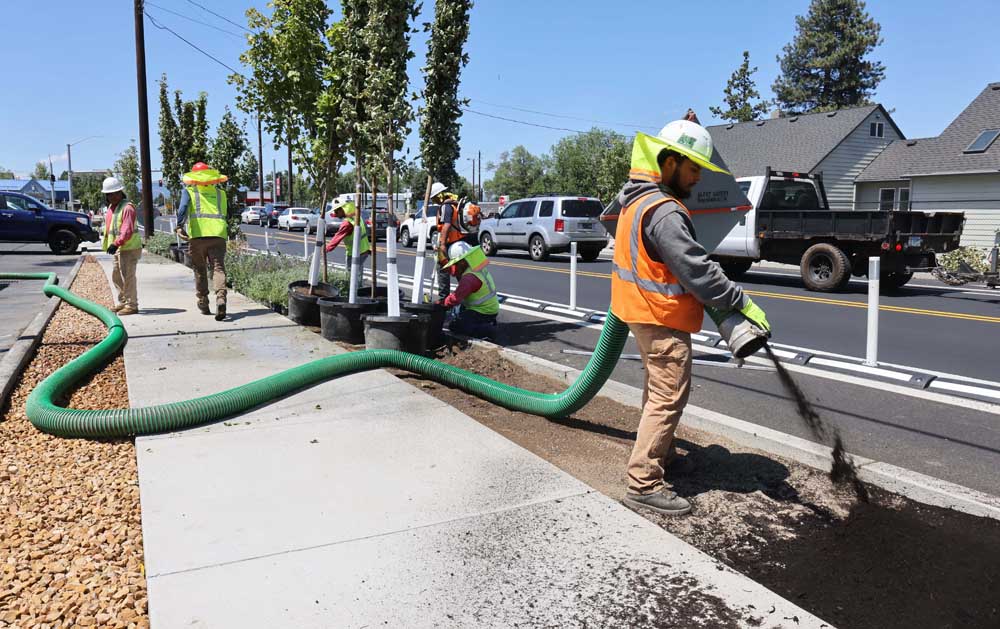Grassy planter strips become latest target in Bend’s effort to conserve water
Published 5:45 am Saturday, July 20, 2024

- A crew with Andres Landscape prepares a planter strip on SE Wilson Avenue in Bend.
A growing effort by the city of Bend to conserve water will soon impact an area of the streetscape that is typically an afterthought — planter strips.
Planter strips are the narrow area sometimes located between a road and the sidewalk. They don’t occur everywhere, as many sidewalks abut the road directly. But where they do occur, planter strips are often landscaped with a water-hungry strip of turf. Starting in November a new code will ban planting turf in these areas.
Trending
The ruling is the latest salvo in the city’s drive to cut water use amid rapid growth, regularly occurring drought and unpredictable snowpack. Slowing the growth of water-intensive landscaping is one way the city plans to head off future water shortages.
“We are also looking at population growth, which continues to happen while our water rights stay the same. So we have the same amount of water in the glass but more straws going into it,” said Dan Denning, water conservation program manager for the city of Bend.
Other methods tried by the city include offering its residents cash incentives to rip out their lawns. And last week the city promoted its water curtailment plan, which can go into effect when water resources are stretched thin.
The rules are meant to curb water use in summer, which can surge in Bend to 26 million gallons per day, compared to just 5 million gallons in winter.
Preventing heat islands
How much water can be saved by not watering lawns in planter strips is uncertain because watering amounts vary, but Denning said lawns typically require two to three times more water than areas planted with drought-resistant vegetation.
Trending
“The difference comes partly from the higher water need of the (cool season) grass species, but also from the influence of inefficiency in the spray-type irrigation that is used to water grass,” said Denning.
Ornamental grasses, shrubs and plants from the city of Bend’s approved plant list will be allowed when planter strips are newly landscaped, while lawns are banned. In addition to lawns, artificial turf is also banned in the new code due to its potential negative impacts on the environment and propensity to heat nearby areas.
“Living plants provide cooling of air through transpiration. The uptake of water and release as gas prevents heat island effects,” Denning said. “By requiring trees and some low water use plantings, we cut the water need but retain the beneficial effects of having living plant material. We are trying to avoid desertification.”
Curbing pollution
Denning adds another reason to avoid synthetic turf: most of it contains PFAS chemicals, also known as forever chemicals because they don’t break down naturally and can persist in soil and water indefinitely. These chemicals could potentially leach into the aquifer from the street strip.
Another reason planter strips are a target: fertilizers. These chemicals placed in planter strips to green up lawns can wash into gutters and storm drains, where they can eventually reach underground aquifers, threatening water supplies.
“So there are two benefits (to the code change), reduced water use and reduced pollution,” said Denning.
Other rules associated with the new code include planting enough vegetation so that half of the planting strip will be covered within five years of planting. Ornamental grasses cannot make up more than a quarter of the plants in the planter strip. As for sprinkler systems, these won’t be permitted in planter strips less than 8 feet wide.
Bend city council mulls plan designed to protect tree canopy
Tree code connection
The ban on turf was part of a package of rules passed by the Bend City Council a month ago when it approved a new tree code designed to prevent the wholesale cutting of trees on private land when homes are built.
Areas of Bend where turf in planter strips already exists in abundance — notably along Bond Street above the Old Mill District — are safe for now because the ban does not retroactively apply to existing turf. The city hopes its existing program to pay individuals and businesses to tear out their lawns will eventually weed out the turf in planter strips.
“Our turf removal program is how we could address existing areas like the turf-intense Old Mill areas,” said Denning.
The Old Mill District has a Deschutes River water right and as such does not require pumping groundwater for its landscaping purposes.
Beau Eastes, a spokesperson for the Old Mill District, said there are no immediate plans to convert the area’s planter strip turf into a more natural landscape. But he did not rule out making such a conversion in the future.
“We are always looking for ways to be better stewards of the land, so if there is some grass we can replace with shrubs, trees wildflowers, that is something we will look into,” said Eastes. “But no immediate plans to rip out any grass in those planter strip areas.”
Reducing per-capita water use
Bend has developed a set of targets to curb its use of water, and the city says the measures are showing signs of progress. New building practices, higher-density homes and water conservation practices have helped drive down per-capita use of water, even as total water use rises due to Bend’s growing population, Denning said.
Current water use is around 157 gallons per person, per day in Bend. By 2040 the city hopes to whittle this number down to 143 gallons per person, per day. Not reaching this goal could result in the need for additional groundwater permits, but there is no guarantee the city will be able to receive these.
Denning said the city is planning on “a worst-case scenario” if future groundwater water permits are denied because of new rules proposed by the state. These rules could prevent municipalities from attaining new rights if data show groundwater levels are decreasing.
“Outdoor water use is our biggest bucket of water to chase,” said Denning. “The planter strips are underutilized areas, so planting high water use crops there doesn’t make sense in the first place.”








